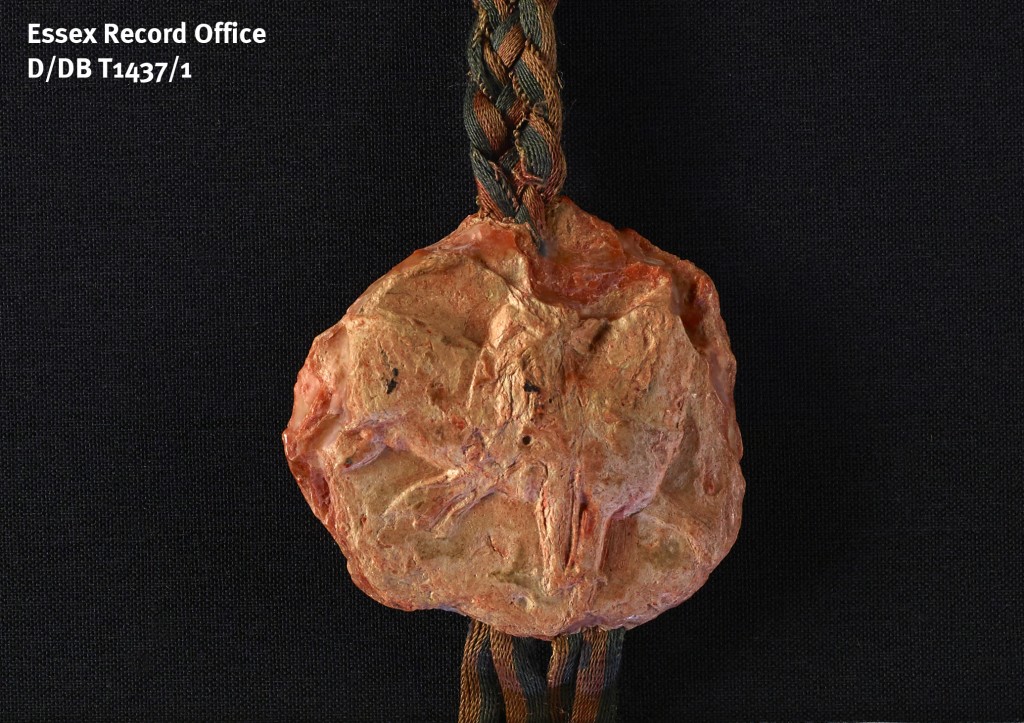Ahead of Magna Carta: Essex Connections on Saturday 23 May, thought we would take a look at two ERO documents from the reign of the infamous King John (1199-1216).
These two documents are featured on the University of East Anglia’s Magna Carta Project website which brings together all of the charters of King John’s reign. Professor Nicholas Vincent, an expert on Magna Carta, leads this project and he will be speaking about Magna Carta at the Essex Record Office’s mini conference on 23 May.
King John issued several thousand charters during his reign. The Magna Carta Project site explains that:
‘The word ‘charter’ covers a multitude of possibilities, but in essence defines a single sheet of parchment on which were recorded commands, requests or most often grants by one party to another… [charters] are often our best, and sometimes our only means of access to the realities of power, of landholding and of administration.’
The Magna Carta Project has been tracking down all the surviving charters of King John’s reign, which can be found in archives around the country (including here at ERO) and bringing digital versions of them together online
The two ERO documents which have been included in the project date from 1203. One is a charter, and the other a letters patent.
The oldest Essex royal charter in the Record Office was granted by King John on 2 May 1203 (D/DB T1437/1). The charter confirmed the judgement made by the king’s justiciar Geoffrey FitzPeter (‘fil Petri’ son of Peter) in the royal court (more on him in another post coming soon). The judgement was that Constance Furre should inherit the lands in Heydon (‘Heyden’) and London of her father Robert Furre, having been judged to be the rightful heir in the court.
This charter was granted while the king was at ‘Auriualla’, the modern Roche d’Orival near Rouen in Normandy. At a time when royal justice was only dispensed by the king or his chief officer, and the ability to defend land through military might was essential, the inheritances of women were particularly vulnerable to counter-claims by others.
This document begins in the conventional way:
‘Joh[anne]s d[e]I gr[ati]a Rex Angl[orum] Dominus Hyb[ern]ie, Dux Norm[annie] et Aquit[annie] Com[es] And[egavie] archiepi[scopi]s epi[scopi]s abb[ati]b[u]s com[itibus] bar[onibus] justice[ariis] vic[ecomitibus] prepo[si]tis minist[ri]s et omnib[u]s ball[ivi]s et fidelib[u]s suis sal[u]t[em]’
(John by the Grace of God, King of England, Lord of Ireland, Duke of Normandy and Aquitaine, Count of Anjou to his archbishops, bishops, abbots, earls, barons, justices, sheriffs, reeves, officers and all bailiffs and subjects greetings.)
This is almost identical with the opening of Magna Carta, which included foresters between the justices and the sheriffs. John was the first English monarch to describe himself as Lord of Ireland, a title he held before he became king.
The Great Seal affixed to the charter confirmed the king’s approval of the contents and would have been used to signify his agreement to Magna Carta. Seals were made of wax and the royal seal was produced using a double-sided metal mould (matrix). It is conventional for royal seals to show the monarch seated on one side holding the orb and sceptre, ready to dispense justice which comes down from the crown. On the other side it is customary to show the monarch on a horse ready to defend the country. The seal here has survived remarkable well considering it is over 800 years old, and it is still possible to make out traces of the royal images impressed into it.
The charter was accompanied by a royal grant by letters patent of 2 April 1203 (D/DB T1437/2). This document confirms that the lands had been delivered to Constance and in turn she declared (quitclaimed) that she had no further claim to the lands, having been paid 15 marks by Thomas de Heydene (the lord of the manor) when she married. Constance kept 1 virgate (approximately 30 acres) of land for herself. A mark was valued at 13s. 4d. and it is estimated that today 13 marks would be worth around £5,000. These letters patent were given at ‘Mullinell’ (Moulineux) in France. The green wax on this seal was used because it was a grant by letters patent (open letter).
Two of the men named as witnesses in this document – Geoffrey FitzPeter and Hugh de Neville – both have interesting stories and Essex connections which we will explore in forthcoming posts.
In the meantime, get in touch on 033301 32500 to book your ticket for Magna Carta: Essex Connections.
Magna Carta: Essex Connections
To explore the significance and legacy of this famous document, both nationally and for Essex, join us for talks from:
- Nicholas Vincent, Professor of Medieval History at the University of East Anglia, who has been leading a major project researching the background to Magna Carta
- Katharine Schofield, ERO Archivist, on Essex connections with Magna Carta and the impact it had on the medieval county
Saturday 23 May, 1.15pm for 1.30am-4.15pm
Tickets: £8, including tea, coffee and cake
Please book in advance on 033301 32500











